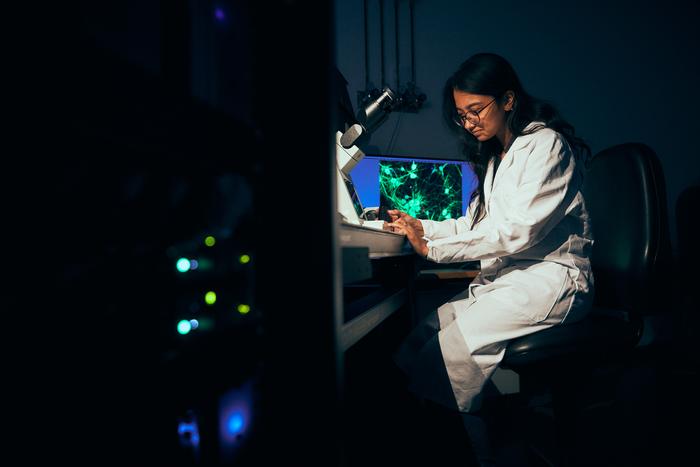Every hug, every handshake, every dexterous act engages and requires touch perception. Therefore, it is essential to understand the molecular basis of touch. “Until now, we had known that the ion channel – Piezo2 – is required for touch perception, but it was clear that this protein alone cannot explain the entirety of touch sensation,” says Professor Gary Lewin, head of the Molecular Physiology of Somatic Sensation Lab at the Max Delbrück Center.

Credit: Katharina Bohm, Max Delbrück Center
Every hug, every handshake, every dexterous act engages and requires touch perception. Therefore, it is essential to understand the molecular basis of touch. “Until now, we had known that the ion channel – Piezo2 – is required for touch perception, but it was clear that this protein alone cannot explain the entirety of touch sensation,” says Professor Gary Lewin, head of the Molecular Physiology of Somatic Sensation Lab at the Max Delbrück Center.
For over 20 years Lewin has been studying the molecular basis of the sensation of touch. He and his team have now discovered a new ion channel, named Elkin1, that plays a vital role in touch perception. This is only the second ion channel implicated in the touch perception. It is likely that the protein is directly involved in converting a mechanical stimulus, such as light touch, into an electrical signal. When Elkin1 is present, the receptors in the skin can transmit the touch signals via nerve fibers, to the central nervous system and brain. The researchers have published their findings in the journal Science.
Lewin’s team came across Elkin1 a few years ago while investigating a malignant melanoma cell line. The researchers had found that the protein is required for sensing mechanical forces by these highly motile cancer cells. “Now we wanted to determine whether the same protein also plays a role in touch sensation” says Lewin.
Lack of Elkin1 reduces touch sensitivity
The researchers bred genetically modified mice that lacked the Elkin1 gene. They then conducted simple behavioral experiments that involved lightly brushing a cotton swab against the rodents’ hind paws. “Usually, normal mice react to the cotton swab 90% of the time,” says Lewin. “In contrast, mice lacking Elkin1 only reacted half of the time, indicating touch insensitivity”. Importantly, the rodents’ reaction to non-mechanical stimuli like temperature was not affected.
At the neuronal level, Dr. Sampurna Chakrabarti, a scientist in Lewin’s team, used the patch clamp method to record the electrical activity of sensory neurons in response to poking of the neuronal membrane. “Around half of the neurons in genetically modified mice lacking Elkin1 didn’t respond to mechanical stimuli, and no signal transmission occurred,” says Chakrabarti. Further experiments confirmed that there were no signals relayed from the neuron’s receptor ending in the skin, on the first leg of the signals journey from skin to the spinal cord and brain. Furthermore, their Australian collaborators in the lab of Professor Mirella Dottori in the University of Wollongong tested whether Elkin1 in necessary for touch transduction in human sensory neurons grown in a petri dish from stem cells. Their findings also strongly suggest that Elkin1 could play a major role in human touch perception.
The researchers assume that during normal signal transmission, Elkin1 and Piezo2 share roles in touch perception. They have also found evidence that Elkin1 may play a part in the transmission of painful mechanical stimuli. “If this is confirmed to be the case, we will have not only identified a second ion channel with an indispensable role in normal touch perception, but also a new potential target for treating chronic pain,” says Lewin.
Further information
- Pain and touch sensations require Schwann cells
- Pain as a disease: Gary Lewin in the Resonator Podcast
- Feeling out fine differences in touch sensitivity
- Portrait of Gary Lewin
- Lewin Lab
Contacts
Prof. Gary Lewin
Head of the Molecular Physiology of Somatic Sensation lab
Max Delbrück Center
+49 30 9406-2270 (office)
Christina Anders
Editor, Communications
Max Delbrück Center
+49 30 9406-2118
Max Delbrück Center
The Max Delbrück Center for Molecular Medicine in the Helmholtz Association (Max Delbrück Center) is one of the world’s leading biomedical research institutions. Max Delbrück, a Berlin native, was a Nobel laureate and one of the founders of molecular biology. At the locations in Berlin-Buch and Mitte, researchers from some 70 countries study human biology – investigating the foundations of life from its most elementary building blocks to systems-wide mechanisms. By understanding what regulates or disrupts the dynamic equilibrium of a cell, an organ, or the entire body, we can prevent diseases, diagnose them earlier, and stop their progression with tailored therapies. Patients should be able to benefit as soon as possible from basic research discoveries. This is why the Max Delbrück Center supports spin-off creation and participates in collaborative networks. It works in close partnership with Charité – Universitätsmedizin Berlin in the jointly-run Experimental and Clinical Research Center (ECRC), the Berlin Institute of Health (BIH) at Charité, and the German Center for Cardiovascular Research (DZHK). Founded in 1992, the Max Delbrück Center today employs 1,800 people and is 90 percent funded by the German federal government and 10 percent by the State of Berlin.
Journal
Science
DOI
10.1126/science.adl0495
Article Title
Touch sensation requires the mechanically-gated ion channel Elkin1
Article Publication Date
1-Mar-2024




